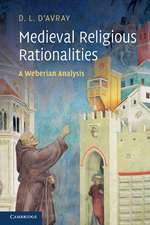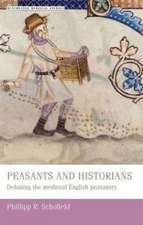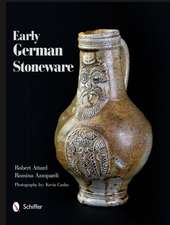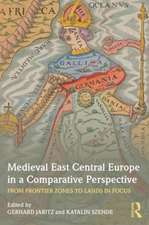Northwest Europe in the Early Middle Ages, c.AD 600–1150: A Comparative Archaeology
Autor Christopher Lovelucken Limba Engleză Paperback – 5 apr 2017
| Toate formatele și edițiile | Preț | Express |
|---|---|---|
| Paperback (1) | 283.74 lei 6-8 săpt. | |
| Cambridge University Press – 5 apr 2017 | 283.74 lei 6-8 săpt. | |
| Hardback (1) | 879.48 lei 6-8 săpt. | |
| Cambridge University Press – 23 oct 2013 | 879.48 lei 6-8 săpt. |
Preț: 283.74 lei
Nou
Puncte Express: 426
Preț estimativ în valută:
54.29€ • 56.83$ • 45.19£
54.29€ • 56.83$ • 45.19£
Carte tipărită la comandă
Livrare economică 31 martie-14 aprilie
Preluare comenzi: 021 569.72.76
Specificații
ISBN-13: 9781316648544
ISBN-10: 1316648540
Pagini: 490
Ilustrații: 45 b/w illus.
Dimensiuni: 172 x 245 x 25 mm
Greutate: 0.78 kg
Editura: Cambridge University Press
Colecția Cambridge University Press
Locul publicării:Cambridge, United Kingdom
ISBN-10: 1316648540
Pagini: 490
Ilustrații: 45 b/w illus.
Dimensiuni: 172 x 245 x 25 mm
Greutate: 0.78 kg
Editura: Cambridge University Press
Colecția Cambridge University Press
Locul publicării:Cambridge, United Kingdom
Cuprins
Part I. Context: 1. Introduction; 2. The social fabric of Northwest Europe, AD 600–1150: paradigms and perspectives; Part II. The Age of the Carolingians, c.AD 600–900: 3. Small farming communities of West Francia, AD 600–900; 4. Larger farming communities, specialist producers and collectors in West Francia, AD 600–900; 5. Farming communities of Anglo-Saxon England and the Atlantic fringes, AD 600–900; 6. Expressions of leadership and models for emulation, AD 500–900; 7. Conspicuous consumption and secular authority in the landscape, AD 650–900; 8. Diocesan towns, AD 600–900; 9. Ports and maritime-oriented societies, AD 600–900; Part III. From the Viking Age to Angevin Hegemony: 10. Transformations in architectures and settings of public power, AD 900–1150; 11. The rural world, AD 900–1150: lifestyles of old and new aristocracies; 12. The rural world, AD 900–1150: social mobility, landscape reorganisation and colonization; 13. Major ports and merchant patricians as catalysts for social change, AD 900–1100; 14. Towns as regional centres and urban diversity, AD 900–1150; 15. Final conclusions.
Recenzii
'… this book is an elegant step in the direction of a new history of this region during a formative era, and for its boldness and breadth it must be welcomed.' Richard Hodges, Antiquity
'This important synthesis of material evidence for early medieval Europe delivers even more than its title promises … a major study that should be essential reading for students and researchers of the period.' Christopher Scull, The Archaeological Journal
'… this is an important book that provides a much-needed comparative overview that cuts across traditional temporal and national boundaries. It is extremely well written and presented, and should be essential reading for any early medieval archaeologist or historian.' Stephen Rippon, Medieval Archaeology
'This book is a rich storehouse [of data], marshalled within a comparative framework undertaken at 'inter-site, regional and supraregional levels', and providing an exploration of the 'mental templates' which governed aspirations and action at all levels of society in the early Middle Ages. The exploration thus enabled is a valuable, thought-provoking and thoroughly enjoyable journey.' Brian Ayers, History
'This is an excellent book. It is theoretically aware and critical in character but not densely speculative as a result; it lays out a mass of archaeological evidence. It provides us with an informative, clearly laid-out and appropriately commented survey of a substantial period within [a] considerable area of [northwest] Europe that has hitherto been far too obscure.' John Hines, Cardiff University
'Christopher Loveluck's magisterial survey of the emergence of medieval Europe from its origins in the fading Roman Empire is a solid contribution to the scholarship of the period.' Susan Oosthuizen, Landscape History
'This important synthesis of material evidence for early medieval Europe delivers even more than its title promises … a major study that should be essential reading for students and researchers of the period.' Christopher Scull, The Archaeological Journal
'… this is an important book that provides a much-needed comparative overview that cuts across traditional temporal and national boundaries. It is extremely well written and presented, and should be essential reading for any early medieval archaeologist or historian.' Stephen Rippon, Medieval Archaeology
'This book is a rich storehouse [of data], marshalled within a comparative framework undertaken at 'inter-site, regional and supraregional levels', and providing an exploration of the 'mental templates' which governed aspirations and action at all levels of society in the early Middle Ages. The exploration thus enabled is a valuable, thought-provoking and thoroughly enjoyable journey.' Brian Ayers, History
'This is an excellent book. It is theoretically aware and critical in character but not densely speculative as a result; it lays out a mass of archaeological evidence. It provides us with an informative, clearly laid-out and appropriately commented survey of a substantial period within [a] considerable area of [northwest] Europe that has hitherto been far too obscure.' John Hines, Cardiff University
'Christopher Loveluck's magisterial survey of the emergence of medieval Europe from its origins in the fading Roman Empire is a solid contribution to the scholarship of the period.' Susan Oosthuizen, Landscape History
Notă biografică
Descriere
Using the most recently discovered archaeological and textual evidence, Christopher Loveluck explores the transformation of Northwest Europe, from c.AD 600 to 1150.



















